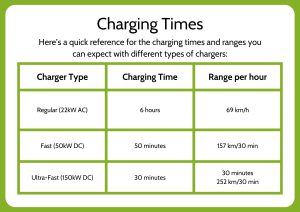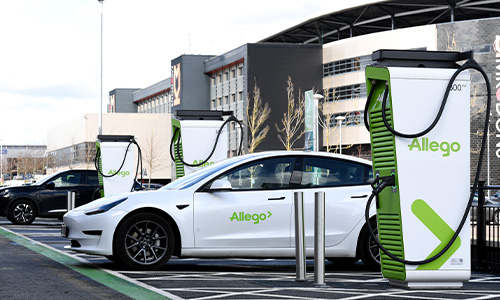

This section of our EV Academy provides a guide to charging the Kia Niro EV, a popular EV that combines practicality with aesthetics. The latest model retains its substantial battery capacity from its predecessor, the e-Niro. Thanks to improvements in design this battery now supports a driving range of 458 km per charge.
Overview – Charging the Kia Niro EV
You’ll find the Kia Niro EV’s charging port located centrally at the front of the vehicle. To access the port, make sure the vehicle is unlocked and switched on, then press the release on the charging door; it will automatically swing open.
Once open, you will see charging connectors for both AC and DC charging: a Type 2 connector for AC regular charging and a CCS connector for fast and ultra-fast DC charging.
Ensure that the port area is clear of debris or water before plugging in the charging cable. The vehicle is equipped with an electronic locking mechanism that secures the charging cable once connected, preventing it from being accidentally disconnected while the vehicle is locked. This lock only disengages when the vehicle is unlocked, allowing for safe removal of the cable.
After you’re done charging, replace any protective covers, close the charging port door, and push it until it clicks to confirm it’s securely closed. This ensures that the charging components are protected and the charge is efficiently completed.
Charging Methods
| Regular: Type 2 | Fast/Ultra-Fast: CCS |
| Max AC 1-phase rate: 7.4kW
Max AC 3-phase rate: 11kW |
Max DC rate: 80 kW |
| Connector location: Front – Middle | Connector location: Front – Middle |
Charging at Home: The Kia Niro EV can be charged using a standard Type 2 connector, which fits most home charging units. For a full charge, connecting to a 7kW home charger typically takes approximately 9.5 hours.
Public Charging: For faster charging, use Allego’s public charging stations equipped with CCS (Combined Charging System) connectors for fast and ultra-fast charging.

Note: Charging times for Regular (22kW AC) shows times taken from empty to full, whereas Fast (50kW DC) and Ultra-Fast shows time taken to charge from 20% to 80 %. Charging times can vary based on factors like ambient temperature, battery state, and charging rate. The maximum charging rate may also be limited by the vehicle.
Vehicle Specifications
| Category | Specification |
| Range | 458 Km |
| 0-100 km/h | 7.8 seconds |
| Top Speed | 165 km/h |
| Engine Power | 150 kW (201 bhp) |
| Torque | 255 Nm |
| Total Battery Size | 64.8 kWh |
| Battery Efficiency (WLTP) | 161.56 Wh/km |



